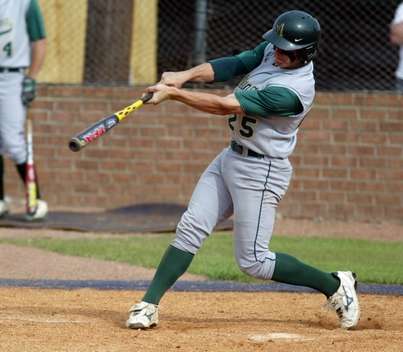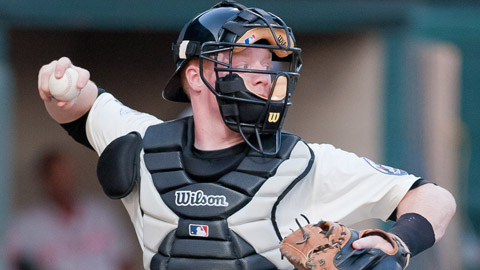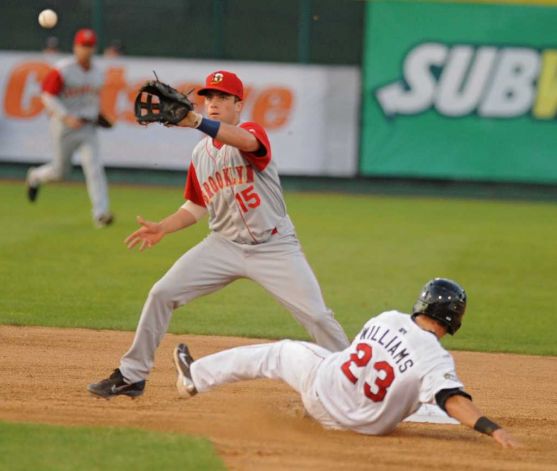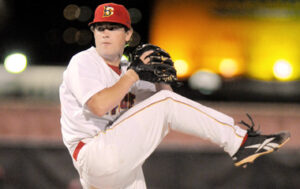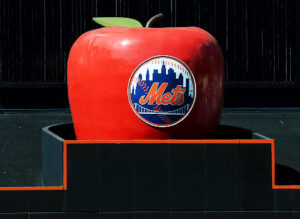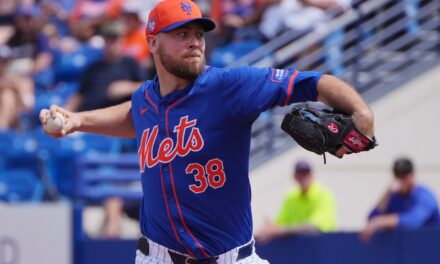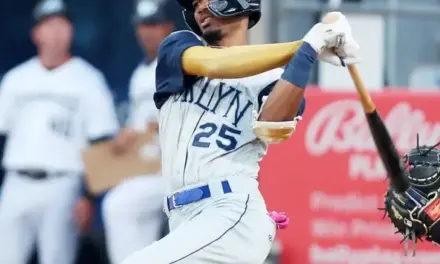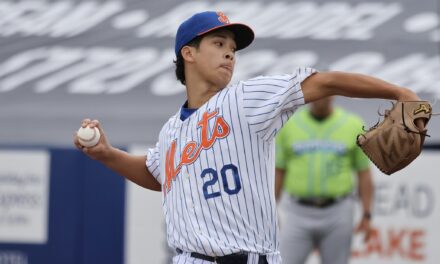With all the mock drafts coming out these days, there is plenty of information surfacing about who the top picks will be, and what their budding skill-sets are like. But what about the Mets? What sort of draft strategy will suit them best heading into the MLB Amateur Draft of 2012?
There is the old school acumen of: “take the best available player each time you pick regardless of position.” But that goes by the assumption that all things are equal. From rounds three on in the draft, all the players pretty much are equal, without much difference as far as projection, and similar chances at development. So why not draft for need, while at the same time taking the best athlete available? In the Mets minor league system, things are far from equal. Some fans really love the direction the organization is heading in regards to the farm system, but that doesn’t mean that they are where they need to be by any means. There is a long way to go. Look at it as the glass is half full, for all you incorrigible optimists out there. The fact is, there are key areas where this organization absolutely must increase the talent pool.
Why haven’t the Mets moved up in the farm system rankings, despite the fact that they have had good drafts, and improved over the last two years? Why are they still ranked in the middle? Or even by some extremely biased anti-Met journalists, one of which recently ranked the Mets system 22nd, or 24th or some such ludicrous thing? That is going a little too far in one’s prejudice against the Mets franchise, but everyone’s entitled to their opinion, even when they’re wrong.
Unfortunately, in the highly competitive environment in which the Mets operate, other teams are improving as fast or faster than the they are, while at the same time established teams like the Braves, Rays, Giants, Angels, and Rangers remain organizationally strong, and merely must maintain their talent pool. This keeps the Mets anchored securely somewhere in the middle-of-the-pack.
As far as drafting the “best available athlete,” the Mets don’t have the luxury of being in that position yet. They have far too many holes in their minor league system, big enough that you could drive a truck through. Huge smoldering craters where lots of talent ought to be residing, but instead you have a fringy prospect or two, at best. What areas are the weakest in the system? Only three of the four most difficult areas from which to harvest talent, and areas of extreme importance to any well balanced team. I am speaking of course, of the following positions: Catcher, Shortstop, Centerfield, and left-handed starting pitching.
Even though the 25-man major league roster has a gaping hole in CF, the Mets have some minor league talent already in place for the position, including Captain Kirk, Brandon Nimmo, Matt den Dekker, Darrell Ceciliani, Tillman Pugh, and Joe Tuschak. And they have a somewhat rich history of developing fine center fielders, with the likes of: Lee Mazzilli, Mookie Wilson, and Lenny Dykstra. So center is not a weak spot any longer. But what of the other three areas? Let’s take a closer look:
CATCHER
With a flawed incumbent occupying the catcher position on the big league level, perhaps no area in the entire organization needs an upgrade as desperately as back-stop. It is the most difficult position on the diamond to develop players at, the most physically demanding, arguably the most important other than the pitcher, and the one position that loses candidates by attrition more often than any other.
The Mets have virtually ignored the catching position for years, and years, and years. For their whole history as a matter of fact. Let’s see, you really can’t count Jerry Grote, since he came in a trade from the Astros, and had been developed by them. Piazza Dodgers, Carter Expos, hmmm. Other than Thole, who have the Mets developed? Help me out here: Stearns? Nope. He came from Philadelphia. Well, there was Todd Hundley, great catcher for a coupla years until he ruined his elbow. Oh, I got one, Ron Hodges, ‘ol number 42. Sweet lefty singles stroke, good catch-and-throw guy. Except he was a back-up. Duffy Dyer, another back-up. Mike Fitzgerald anybody?
Needless to say, we haven’t exactly been the Yankees when it comes to finding catchers, that’s for sure. Who’s here already? Well there’s Albert Cordero who is showing some offensive and defensive promise, and will play at High-A ball this year. There’s Juan Centeno, who will play at AA this year. Juan’s a good catch-and-throw guy, who has made good contact, in very limited opportunities. In five seasons in the Mets farm system he has only averaged about 99 AB’s per year, so he really needs to get an extended opportunity to even know if they have anything there at all.
Then there’s Cam Maron who started as a raw lump of clay with catcher’s gear, and is developing very nicely into a real, live catcher, with a certain degree of athleticism. His bat shows some definite promise too, but he’s still perhaps four or five years away from the bigs. Then, if you are looking for that dark-horse to root for. The candidate here would be the only catcher that the Mets actually spent a reasonably high draft pick on recently to acquire. That would be Blake Forsythe the 2010 3rd round draft pick out of Tennessee. Cordero was an IFA, and both Centeno and Maron were 30-something round draft picks.
Forsythe has been pretty much a bust so far in his first two seasons, so this year will be crucial for him. He does have a lot going for him though. He is an excellent defensive catcher, although he still needs to work at improving his lifetime 30% CS rate. That would not be too far fetched though, since Forsythe is perhaps the most tireless worker in the entire system. First to arrive, last to leave, that sort of thing. As a hitter he shows plus power potential, but he also will face the unenviable task, of cutting way down on his strikeouts, as he works his way up into tougher and tougher levels of the minors. At best he is two to three years away from being considered for a big league chance.
And that’s pretty much it. Jeff Diehl, last year’s over-slot draft signing, will be moving off of catcher this year, most likely to first-base. None of the other catchers in the system profile as major league prospects. So what does this say as far as the upcoming draft and how the Mets should be approaching it? Obviously catcher is a position that the Mets should be targeting and restocking from the top to the bottom of the system. The idea of bringing in as many as three or four catching prospects this spring should not be out of the realm of possibility, and should be made a reality. Hopefully after more than a year to evaluate what they have and where they want to go, the front office will for once, put some significance on the position of catcher in this organization.
SHORTSTOP
Okay, let’s see if we can name them. Buddy Harrelson, of course. Rey Rey Ordonez, of course. Kevin Elster? Eh. The man who will always be beloved to Mets fans Jose Reyes, of course. But could that be it? Raffy Santana came from the Cardinals, Frank Taveras from the Pirates. Jose Oquendo came up as a Met shortstop, but went to the Cardinals after just two seasons as a Met. He was traded to the Cards at the start of the 1985 season, at the tender age of 20. The Red-Birds then made him into a super-utility player, since they already had a guy at short by the name of Ozzie Smith. So let me get this straight, the Mets have only developed three exceptional shortstops in their history? Yup, three, Reyes, Harrelson, and Ordonez. Well with the F.O. pretty much knowing for a while that they were going to lose Reyes, they must have stocked the system with shortstop prospects, no? Well er, no. Not exactly.
The wild-card is Jordany Valdespin, who is hardly a shortstop at all. He certainly hasn’t fielded like one since he was placed at that all-important defensive position. His mind, it seems is on other things which keeps him from exerting maximum effort when it comes to his “D.” What other things? Himself, his hitting, and mostly himself. In addition to working on his defense he has also not embraced the “team” concept very strongly as of yet. Who knows if he ever will.
In 623 lifetime chances, over four seasons as a SS, Spin has a fielding % of .921. Ouch. I don’t care if he hits like Rogers Hornsby, I’m not putting him in there at shortstop, sorry. Not until he proves he can play the position. For all you big Valdespin fans out there, yes both of you, I will throw you a bone. His lifetime fielding % at second-base is better. In 982 chances over five seasons at 2B, his Fld% is: .968. Marvelous. Until he does better, I wouldn’t let him play there at Citi either.
There are a couple of young infielders, who are very exciting prospects, Phil Evans, and J.C. Gamboa. Unfortunately they won’t be ready for big league action for at least three years. And there is a good chance that Evans may be moved to second-base at some point. Same holds true for Danny Muno, who’s a little bit older than those guys, but second-base may be in his future someday, as well. It goes without saying, with Ruben Tejada the only thing standing between shortstop at Citifield and Omar Quintanilla, it makes me yearn for that viable shortstop prospect even more. In addition to catcher, the team needs to get serious about over-hauling and restocking the shortstop position throughout the organization.
LEFT-HANDED STARTERS
Ok, I know this is going to be a short list. Before I name them, I want to point out that Sid Fernandez was acquired from the Dodgers, another amazing trade courtesy of the great Frank Cashen. Over the years, the Mets acquired a lot of big name lefties at the end of their careers. We had the pleasure of the great Frankie Viola, showing the Shea faithful how it’s done for two plus seasons, and also saw the last major league gasps, while wearing blue and orange, by such immortals as: Warren Spahn, Mickey Lolich, Randy Jones, John Candelaria, and Tom Glavine. We even got some serviceable lefties who had been around a little, but played important roles on Mets teams like: Al Jackson, Bobby Ojeda, Don Cardwell, George Stone, Al Leiter, and Johan Santana.
But how many good lefty starters have the Mets produced from their farm system in their 50 year history? Two. That’s right. Unless you count Jonathan Niese, which I don’t, not yet. He has a shot at being considered a great lefty in Mets history someday, but first he needs to show us something over a long period of time. Like the two south-paws who did make this list: the great Jerry Koosman, and Jon Matlack. But come on guys! Can we please get serious about something as important as left-handed starting pitching? Instead of bringing in Ollie Perez, or Kenny Rogers, why don’t we develop our own stable of lefties down on the farm?
Right now, things are looking better as far as lefty relief throughout the system. The emergence of such power-armed port-siders as: Rob Carson, Josh Edgin, and Adam Kolarek, and the fading promise of Eric Niesen finding his command, give some hope to Mets fans that a few LOOGY’s may be on the way. But what of the starters? Well, of course there’s Darin Gorski, still two years away, and not necessarily a starter at the big league level. There’s Juan Urbina, but he’s at least three years away. There’s Jack Leathersich, but no one knows at this time, if he will ultimately wind up pitching in the rotation, or in relief. And let’s not forget Steve Matz, and Zach Dotson, two completely unknown commodities trying to come back from injuries and career derailment, who are both at least three to four years away. Then you have a handful of IFA’s who are like 17-years-old, and have only just arrived stateside, not exactly the cavalry.
You don’t have to be Branch Rickey to see that an influx of left-handed pitching is in order. Hopefully this huge void will start to be filled this year with the upcoming draft. With such a long lag time between players entering the system, and when and if they finally make the majors, it is a priority to have prospects at these positions at each level throughout the system. Only then will Mets fans have the security of knowing that their farm system is one of the best. Healthy, strong, and self-sufficient. And the fruits of this will be harvested and enjoyed, for years to come.

